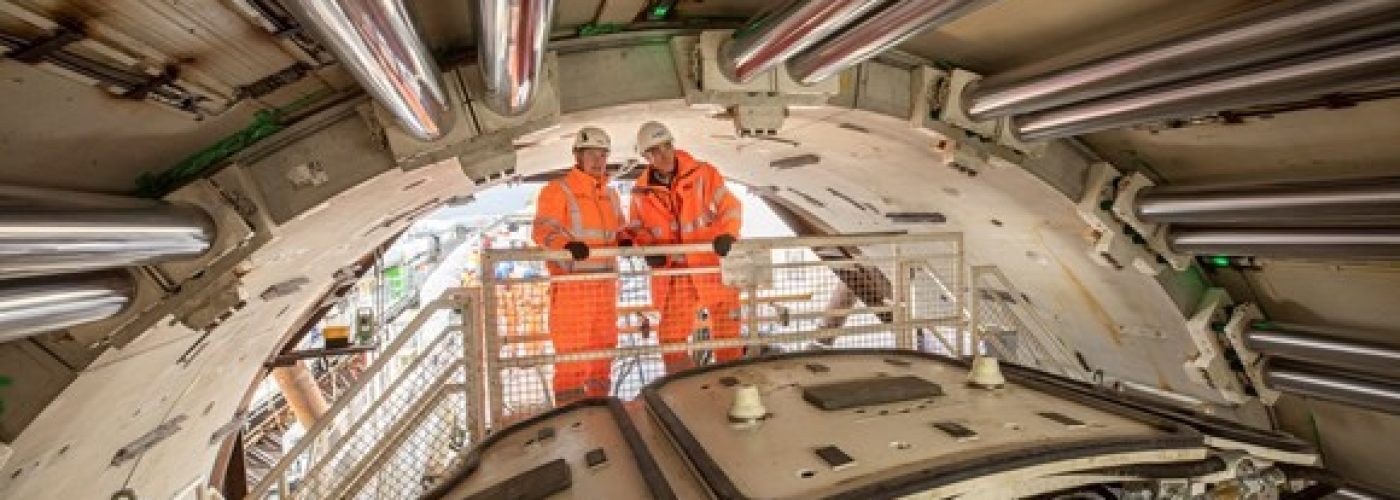Hot on the heels of HS2’s first London TBM, ‘Sushila’, who set off earlier this month, the 2,000 tonnes TBM, ‘Caroline’ has today begun the 5-mile journey towards Greenford from West Ruislip in West London
TBM named after ‘first professional’ female astronomer Caroline Herschel
HS2 Ltd has just launched the fifth Tunnel Boring Machine (TBM), ‘Caroline’, that will be constructing tunnels for the HS2 railway through London. The second launched in the capital, the 2,000 tonnes machine joins ‘Sushila’, that was switched on earlier this month on the same West London site.
Named after 18th century astronomer Caroline Herschel, the giant machine will now dig for 22 months, non-stop except for Christmas Day, towards Greenpark way in Greenford – boring five miles of the twin-bore Northolt Tunnel. ‘Caroline’ will be operated by a crew of 15 people, working in shifts. An additional 25 people will directly support each tunnel drive on the surface.
Travelling at an average of 14m per day, ‘Caroline’ will dig the five-mile tunnel and install 4,207 tunnel segment rings to create the tunnel. Each ring of the tunnel is made up of seven concrete segments which have been manufactured in the UK by Pacadar based in Kent.
The machine was switched on by HS2’s Civils Delivery Director, Mike Lyons, who said:
“HS2’s construction continues to gather pace, and the launch of the fifth Tunnel Boring Machine on HS2 is another significant moment for Britain’s number one levelling-up project.
“Creating jobs and contracts for businesses today, HS2 is an investment in Britain’s economic growth now and for generations of rail passengers to come.”
The machine was given the name ‘Caroline’ after it was put forward by pupils at Brentside Primary Academy in Ealing, who were inspired by her contribution to astronomy whilst learning about earth and space in their science lessons. German-born British astronomer Caroline Herschel was considered the first professional female astronomer. In her career she discovered three new nebulae (hazy clouds where stars form) and was the first woman to ever discover a comet in 1786. She compiled a catalogue of 2500 nebulae and, in 1828, the Royal Astronomical Society awarded her its gold medal for this work.
‘Caroline’ will be operated by Skanska Costain STRABAG JV (SCS JV), HS2’s Main Works Civils Contractor constructing the HS2 tunnels in London. She joins ‘Sushila’ who has already travelled over 70m in the three weeks since launch.
James Richardson, Managing Director of Skanska Costain STRABAG JV said:
“We’re delighted to have begun our tunnelling journey towards Euston, travelling under one of the busiest cities in the world. Getting to this point has been a huge team effort and the scale of this programme has enabled many new people to join the industry and work on this crucial national infrastructure project.”
Once ‘Caroline’ and ‘Sushila’ reach their destination at Greenpark Way, they will be dismantled and extracted from a 40m deep shaft.
Separately, two other equally massive tunnel boring machines will set off towards Greenpark Way from HS2’s Victoria Road site in 2023 to build a further 3.4mile twin-bore tunnel. Combined, the quartet of TBMs will build 8.4miles of twin bored tunnels between West Ruislip and the new high speed rail super hub station at Old Oak Common.
Further facts about the TBMS:
- Each machine is 140 metres in length, one and a quarter times the length of a football pitch
- Each has a cutter head that is 9.84m in diameter, almost as tall as two giraffes standing on top of each other
- They each weigh approximately 2,050 tonnes, roughly the weight of 10 blue whales
- 2 million cubic metres of excavated material will be removed, weighing 2.46 million tonnes
- A single tunnel segment ring weighs 8.5 tonnes
Another tunnel 4.5 mile twin-bore tunnel extending from Old Oak Common to Euston will complete HS2’s journey to its London terminus. Spoil from the tunnels at West Ruislip will not travel far as it will be used for sustainable placement to the North, creating embankments for the new railway, as well as new environmental habitats. It will also be used to remodel the West Ruislip golf course which is closed during HS2 construction.





